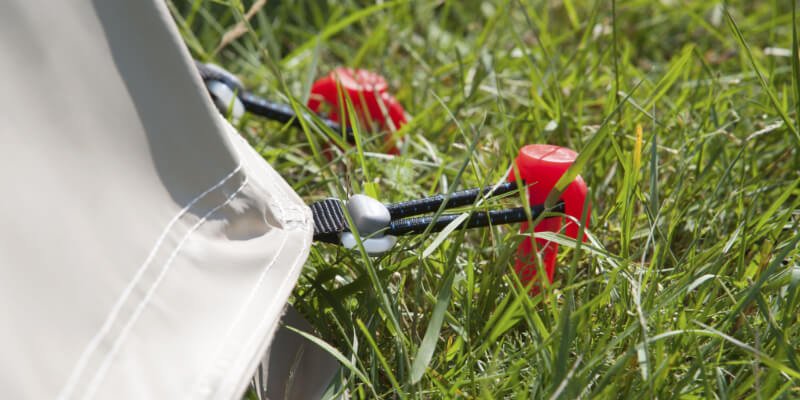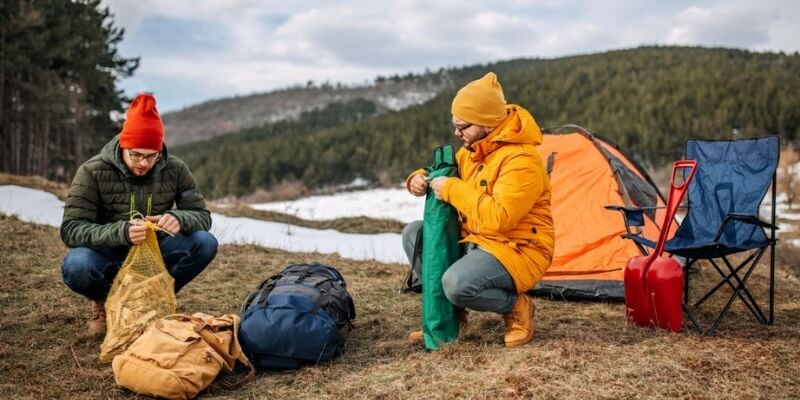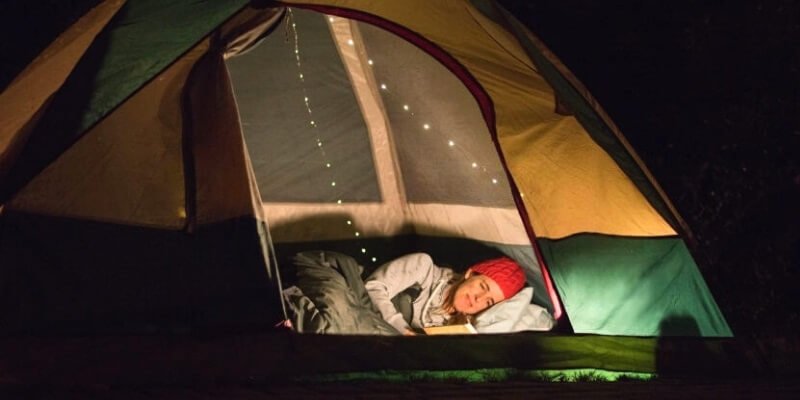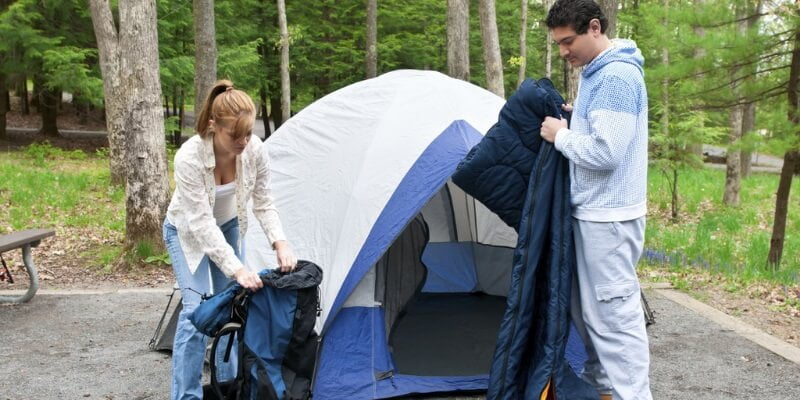Different Types of Tents Explained (with Photos)
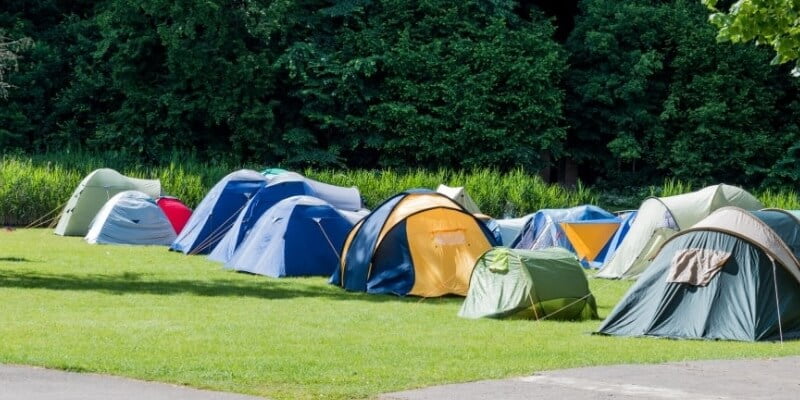
Tents are designed to provide temporary shelter for outdoor activities such as camping, backpacking, hiking, and various events. They’re built in different styles, sizes, and configurations to suit different needs and environments. Each type of tent comes with specific features and characteristics to fit various purposes, weather conditions, and group sizes.
Whether you’re embarking on a lightweight hiking trip, planning a week-long holiday at a campsite with friends and family, or braving winter conditions in snow and storms, there’s a tent designed to fit your needs. Here, we explore 9 popular types of tents, highlighting their pros and cons.
The 9 Most Common Types of Tents
Here are the 9 most common types of tents:
1. Pop Up Tent
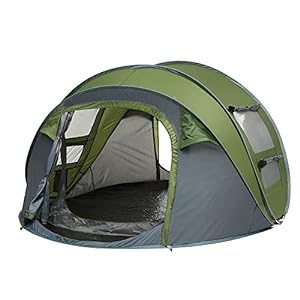
Instant or pop-up tents can be set up incredibly quickly. You take them out of the transport bag and throw them in the air. When the tent lands on the ground, it is already set up! This feature makes the pop-up tents perfect for festivals and newcomers to camping.
Pop-up tents are made with a simple trick. The flexible poles are ring-shaped and firmly connected to the fabric. During dismantling, the tent is twisted together with a little force until it looks like a round, flat disc. If you let go of the pane, the spring force of the fiberglass poles will erect the tent by itself. Currently, there are pop-up tent sizes for 1-5 people.
- Recommendation: Weanas Easy Pop-Up Tent is light and instant setup. Thanks to its all-around sewn groundsheet and inner tent, it cuts a fine figure even in the rain and cold. It has a dismantling aid that makes it easier to fold the tent up.
Advantages:
- 10 seconds to set up and 1 minute to dismantle
- It can stand without bracing
- Need very little floor space
- Easy to carry
- Affordable
Disadvantages:
- Dismantling requires the right technique and a little practice
- Nothing for the rucksack
- Difficult to repair
- Less customization
2. Dome Tent (Igloo)
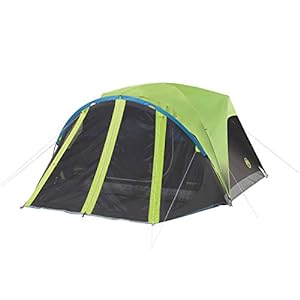
Dome tents are small. This type of tent comes in different shapes. It is the egg-laying woolly milk pig among the tent types: You can set it up in 15 minutes. It is reasonably stable, compared to pop-up tent. In the wind, it offers more space than the pop-up tent. Dome tents are accessible to anyone.
The dome tent isn’t exceptional in any particular area—structure, stability, space, or weight—but it also lacks significant weaknesses. This balance makes it suitable for hiking trips, small groups, handling bad weather, and even festivals. Its versatility rightly makes it the most popular type of tent.
Dome tents consist of two poles, which intersect at the tent top. Usually, the inner tent is hung on the underside of the arches. The outer tent is then pulled over it. However, most extended dome tents have an apse. You can stow your luggage and offer space for 2 to 5 people.
- Recommendation: Coleman Carlsbad dome tent has space for 4 people, 2 entrances for good ventilation in summer, and 2 vestibules with plenty of storage space for your luggage. This also makes it suitable for a longer stay on the campsite.
Advantages:
- Set up without pegs
- Universally applicable
- Available in different sizes and shapes
- Good value for the money
- Lightweight
Disadvantages:
- Small apse
- Limited room divisions
- Not very stable in heavy winds
- Inner tent can get wet on rainy days
3. Tunnel Tent
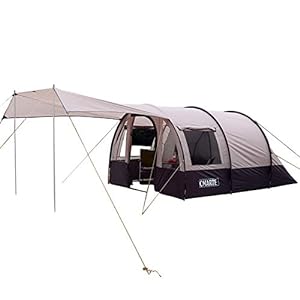
Tunnel tents are popular for a reason: they are true space savers, with a design that maximizes usable interior area. In larger models, the vertical space is generous enough that a person standing 1.90 meters tall and weighing 100 kilograms can comfortably stand upright, making it easier to move around inside.
Small tunnel tents are lightweight due to their efficient use of material. This makes them particularly appealing to trekking enthusiasts. The structure consists of several parallel poles, giving the tent its distinctive tunnel shape. The sleeping area is located at the rear and the front features a spacious vestibule.
In larger models, this area is big enough to fit a full seating group. Some designs allow the front wall to be removed, and the side walls can be opened, turning the vestibule into a pavilion. Tunnel tents range in size, fitting anywhere from 1 to 8 people.
- Recommendation: CMARTE big tunnel tent for 6-8 people has a spacious vestibule where you can store your equipment at night and relax during the day when the weather is not great. 3 doors and large windows ensure excellent ventilation on hot days.
Advantages:
- Best use of space thanks to steep walls
- You can comfortably stand upright
- Very stable in windy conditions
- Comfortable for extended stays
- Good ventilation
Disadvantages:
- Not free-standing
- Needs a large floor space
- The high profile makes it prone to crosswinds
4. Geodesic Dome Tent
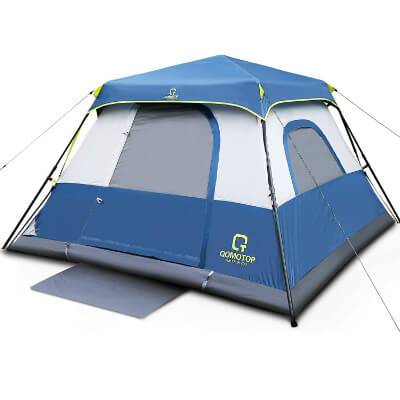
Robust – the geodesic tent is an indestructible fortress. It protects against wind, rain, and snow better than any other type of tent. This makes the geodesic a reliable companion for expeditions and windy areas such as mountains and coasts. The geodesic is a hemispherical tent with three or more crossed poles. So it has more poles than the dome tent – that’s what makes it so stable.
However, it is relatively heavy and expensive. The poles also give the tent its name: They form geodetic lines on the tent’s surface. To enhance wind resistance, geodesic tents are designed with a low-profile cross-section, which reduces their exposure to strong winds. These tents provide space for 1 to 4 people.
- Recommendation: The OT QOMOTOP is not the lightest tent, but its construction and high-quality materials such as the aluminum frame with T6 hardness make it extremely robust. It can face strong winds and you can set up within a few minutes.
Advantages:
- Extremely robust
- resistant to rain, wind, and so on
- Lasts longer than other tents
- 2 or more entrances
Disadvantage:
- Comparatively heavy
- Little headroom, too small for larger groups
- High price
5. Inflatable Tent (Air Tent)

Inflatable tents replace traditional tent poles with air-filled tubes. These tubes are inflated using a hand or electric pump, as they are integrated into the fabric structure. Once inflated, the air tent stands on its own and can be set up within minutes.
Most inflatable tents are tunnel-shaped. They are surprisingly wind-stable – the air hoses sway in the wind but don’t break like tent poles. However, inflatable tents are heavy because of the robustly sheathed tubes. They weigh significantly more than comparable tents with poles.
Inflatable tents are available for 2 – 8 people. Most models are large and have plenty of space inside the tent. The comfortable structure and the most upscale features such as a heat-repellent coating and darkened sleeping cabins make it the perfect glamping tent for campsites.
- Recommendation: HEIMPLANET is an experienced tent manufacturer and expert in air tent technology. HEIMPLANET Original air tent for 5 people with its large apse offers enough space for a comfortable weekend with friends and family and is extremely bright thanks to large windows and doors.
Advantages:
- Setup and dismantling only take a few minutes
- Easy to set up without secondhand help
- Air hoses with adhesive patches
Disadvantage:
- Heavier than other types of tents
- Less known and comparatively expensive
- Occasional re-pumping is necessary if the temperature fluctuates significantly
6. Pyramid Tent (Tipi)
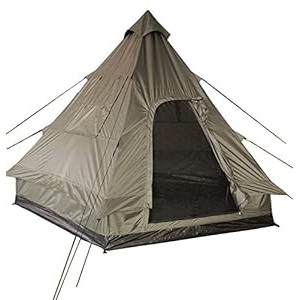
The pyramid tent features a tall, pyramid-like shape and a straightforward design. A single central pole supports the tarpaulin, which is then tensioned at the corners. This minimalist construction makes the pyramid tent exceptionally lightweight, making it a great choice for trekking and minimalist camping.
Pyramid tents are usually single-walled. This quickly leads to problems from condensation. However, the shape of the tent allows good ventilation: Warm, moist air rises and can leave the tent through the opening at the top of the tent. Better-equipped pyramid tents bring a sewn-on groundsheet and a mosquito net for the entrance. Some models even offer an optional inner tent – but this is an exception.
There are many models for 2-8 people. In a large pyramid model, you can stand comfortably in the middle of the tent. Traditionally constructed tipis with external tent poles have a special advantage: The large tent height allows open fire in the middle of the tent – a practical way to heat the tent in winter.
- Recommendation: Mil-Tec Pyramid Tent is absolutely weatherproof. It comes complete with extra-light aluminum poles and an inner tent. It weighs only 14.02 pounds – with 105sq ft space.
Advantages:
- Simple construction makes light
- Fast assembly: only one pole needs to be set up
- Even tall people can stand comfortably
Disadvantage:
- Tent pole in the middle can cause bruises and headaches
- The sloping walls result in poor use of space
- Without bracing, the tent tips over
7. Multi-Room Tent

Multi-room tent consists of several sleeping cabins that lead into a central living area. It has several rooms like a “real house”. The sleeping cabins have their doors. This design is great for families and groups camping. Everyone has a bit of privacy in their private compartment, and in the evening everyone can relax together in the living area. The steep walls create a spacious living area, making it easy to set up camping furniture.
Multi-room tents are big and heavy. They are therefore best suited for camping by car. To reduce weight and price, some manufacturers include thin fiberglass rods. These then break quickly. Better: steel or aluminum bars! There are multi-room tents for 8-12 people. Small families with 4 members often opt for large 8-person tents – more space means more comfort.
- Recommendation: KTT Large tent has 2 Rooms, a Straight Wall, 3 Doors, and 3 Windows. 3 Doors and 3 Windows supply the tent with fresh air. Thanks to Fiberglass Tent Poles, it is more robust than other tents in its class.
Advantages:
- Lots of privacy and retreat options
- Plenty of space for camping furniture
- Comfortable standing is possible in the living area
Disadvantage:
- Not very stable in the wind
- It takes a long time to set up
- Lots of seams that can potentially leak
8. Backpacking Tent
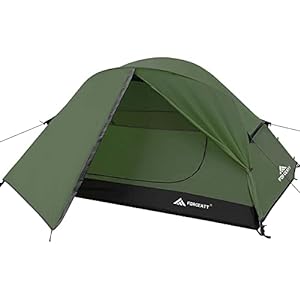
These tents are not in the shape of a rucksack. They are made to be carried in a rucksack for days on hikes. The ideal backpacking tent is light, stable, weatherproof, quick to assemble and dismantle, and offers enough space to sleep and stow your luggage.
Backpacking tents are free-standing. You can set them up quickly and in almost any location because they don’t take up a lot of space. However, it is tight in the inside – these small tents offer space for 1 – 3 people. And most models make it difficult to sit upright. But the tent is easy to carry during the day. Good models weigh less than 1000 grams per person.
- Recommendation: the Forceatt Cloud-Up 4 Seasons tent for 2 or 3 people is made of nylon and aluminum. That makes it robust and very light at 2.5 kilograms. The self-standing inner tent keeps warmth in and insects out.
Advantages:
- Very light: Less than 1000 grams per person
- Freestanding: set up and taken down quickly
- The low profile ensures wind stability
Disadvantage:
- Sitting upright is often not possible
- Only available in small sizes for up to 3 people
- Comparatively expensive
Reading tip: In our guide The budget backpacking tent – features, advantages & disadvantages, we answer all the important questions about this interesting type of tent.
9. Rooftop Tent

A rooftop tent is a compact camping solution that mounts on the roof of a vehicle. These tents feature a foldable design that allows easy setup and takedown, often built with a mattress. Rooftop tents come with a weather-resistant outer layer, sturdy frame, and mesh windows for ventilation.
They’re Ideal for road trips, overlanding adventures, and camping in remote locations. They can be used on most vehicles equipped with roof racks. The elevated position also provides better views and increased safety from wildlife.
- Recommendation: The Thule Tepui Explorer Kukenam 3 is an excellent rooftop tent option. It features a spacious design for up to three people, a durable, waterproof canopy, and a built-in mattress for comfort. It has an integrated ladder and sturdy mounting system.
Advantages:
- Protects from pests and uneven ground
- Quick setup and takedown
- Better views and ventilation
- Durable and weather-resistant materials
- Versatile for road trips and remote camping
Disadvantage:
- Limited space compared to ground tents
- Higher cost than traditional tents
- Requires a compatible vehicle with roof racks
10. Tarp Or Hammock Shelter
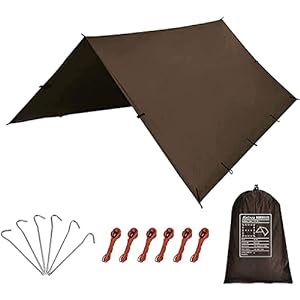
The simplest and lightest tent construction is the tarp. It is a tarpaulin with loops to attach guy ropes to. The tarp is tensioned between 2 trees or a tree and the ground. Alternatively, you can use a trekking stick or branch as a tent pole. Then only the corners of the tarp have to be attached to the floor.
You will have a roof for the night within a few minutes. But no more: A tarp is open all around and offers no protection from insects and changing winds. Because of its low weight and quick setup, a tarp is perfect for trekking and people who want to experience as much nature as possible while camping.
- Recommendation: It doesn’t get much easier – KALINCO Hammocks Tarp is 10X10FT in size and weighs only 2.38 pounds – but it only keeps out rain and sun. It is waterproof and has many sensibly placed loops for tensioning. You can replace the included pegs with better ones.
Advantages:
- Extremely light
- Take a little space in the backpack
- Great outdoor feeling: you (almost) sleep outdoors
- Optimal ventilation and pleasantly cool
Disadvantage:
- Poor protection from wind and rain
- Not good enough against insects
- Not free-standing: assembly possible with bracing
Conclusion
Understanding the different types of tents is essential for choosing the right one for your outdoor adventures. From the versatile dome tent to the spacious tunnel tent and the innovative rooftop tent, each style offers unique features designed to meet specific needs and environments. Whether you’re a solo camper, camping with family, or exploring rugged terrain, there’s a tent designed to meet your expectations. Consider factors such as space, weight, weather resistance, and ease of setup before making the final decision.

